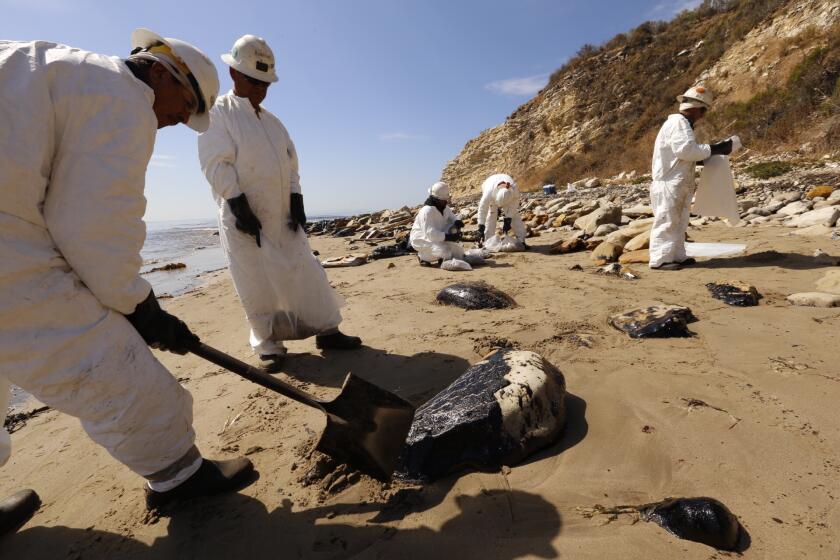
From the sprawling vineyards of the Bay Area to the strawberry fields of the Central Coast and orchards of the Central Valley, California remains an agricultural juggernaut, producing more fruits, vegetables and nuts than any other state in the nation.
But every year, California growers apply more than 180 million pounds of pesticides to crops in an effort to defend them from weeds, fungi, insects and other pests.
Now, state regulators report that they have found detectable levels of pesticides floating in the air in multiple, large farming regions.
Although state officials insist that none of the samples exceeded safe limits, environmentalists and anti-pesticide activists say the compounds pose a far greater risk than the state is willing to acknowledge.
“These are chemicals that are designed, often to be biologically active,” said David Andrews, a senior scientist with the nonprofit Environmental Working Group. “Pesticides, broadly, are linked to such an incredible range of health problems, from cancer to hormone disruption to impact on the immune system. California is a major producer of food crops, and there are significant concerns about the racial and social disparities in exposure to pesticides.”
An EPA directive that all drinking water systems in the nation remove their lead pipes may not solve contamination concerns at L.A. public housing complexes.
According to a new state report, the California Department of Pesticide Regulation, or CDPR, collected weekly air samples last year in Oxnard, Santa Maria, Shafter and Watsonville, and found pesticides in nearly 80% of the samples.
Eight pesticides were found at the air monitoring stations, including 1,3-dichloropropene, a fumigant and probable human carcinogen used to kill crop-damaging pests in soil. That pesticide was found at all four monitoring sites. At least one type of pesticide was found in 163 of the 207 samples.
Environmental groups say the testing demonstrates that these chemicals are drifting into nearby communities and being inhaled by passersby. The compounds have been linked to a variety of health conditions, including respiratory illness, neurological issues and some types of cancers, they say.
“People need to let the state know that we can’t continue growing food by poisoning neighbors,” said Jane Sellen, co-director of Californians for Pesticide Reform. “Fumigation is just unsustainable. It gets everywhere, it drifts for miles and it hangs around for days. It causes cancer, and there’s no avoiding it. And we see that from these air monitoring results.”
All detected pesticides were found below state-established health limits, meaning they are “unlikely to be harmful to human health,” according to the CDPR air monitoring report.
The report comes as state regulators evaluate the use of chloropicrin, a lung-irritating soil fumigant, which was measured just shy of state limits in August 2023 in Oxnard — a city that touts itself as the strawberry capital of the world.
“Monitoring the air in communities with high pesticide use is critical to keeping California safe for everyone,” said CDPR Director Julie Henderson. “I am encouraged to see that all of the 2023 pesticide concentrations fall below our health screening levels. We are still evaluating the concentrations of chloropicrin and are committed to continue collecting and reviewing our data rigorously to identify areas of potential concern, trend lines or anomalies that indicate a need for closer investigation or action.”
Environmental advocates, however, have accused the state of downplaying the results of air sampling. They contend that prolonged exposure to these chemicals, even in small quantities, is not safe.
Recent studies have found pesticide use is more prevalent in predominantly Latino communities in California, underscoring a heightened risk for farm laborers and rural residents.
Plans to restart a pipeline in Santa Barbara County have angered residents worried about an oil spill similar to the massive one near Refugio State Beach in 2015.
Adding to concerns, all four CDPR pesticide monitoring sites are located at schools.
Under state law, pesticides cannot be applied within a quarter-mile of schools and daycare centers during school hours. Companies handling pesticides must notify schools if they do spread chemicals within these areas.
The results coincide with a larger fight over whether the state’s pesticide limits are protective. In particular, environmental groups and state regulators have clashed over state limits for 1,3-dichloropropene.
In 2022, the Office of Environmental Health Hazard Assessment (OEHHA) established a limit for workers of 0.04 parts per billion for 1,3-dichloropropene. That’s 14 times less than the proposed limit under CDPR, which has been fiercely contested and will be reexamined in the coming months.
“This is the third most heavily used pesticide in California,” Sellen said. “No one’s heard of it. No one’s paying attention. And it’s scary. When they say, ‘Don’t worry, all levels were below the level of concern,’ that is not the legal level set by OEHHA.”
But instead of establishing stricter regulatory limits, some would like to see a shift away from using pesticides altogether. The state’s 3,000 organic farms have shown that it’s possible, according to Sellen.
“In California, we can grow without using these chemicals,” Sellen said. “For all of human history, we did exactly that until the last 50 or so years. The way ag is practiced in California is not sustainable and needs to change.”
CDPR will present the air monitoring at a virtual public meeting at 10 a.m. Friday.









